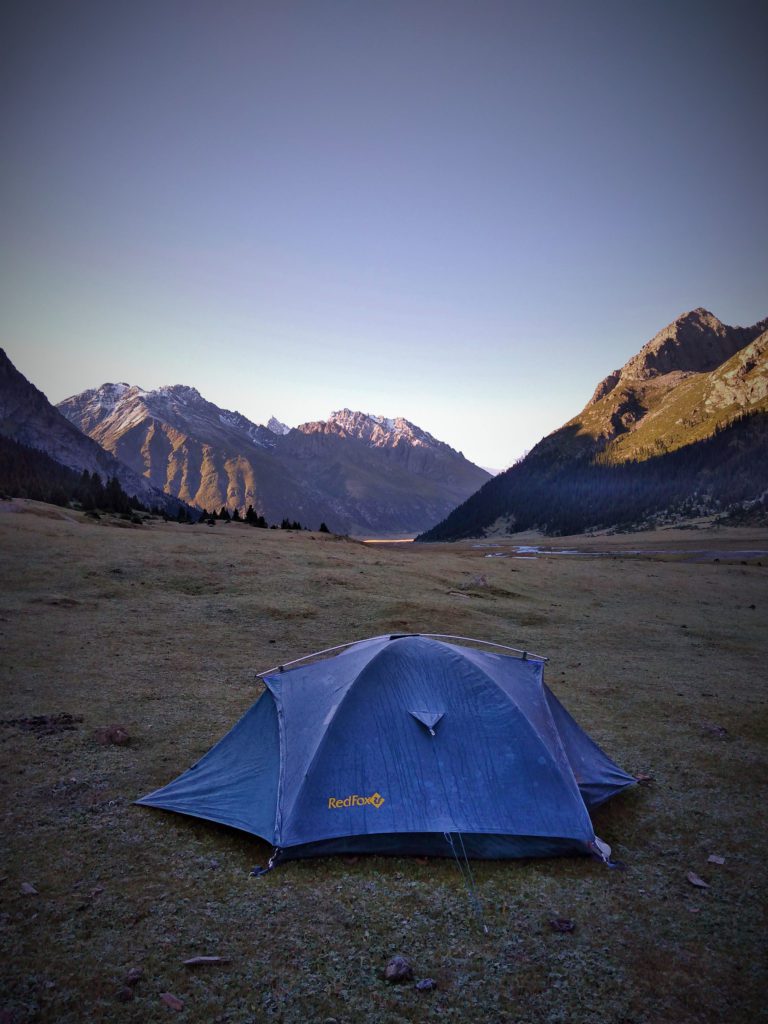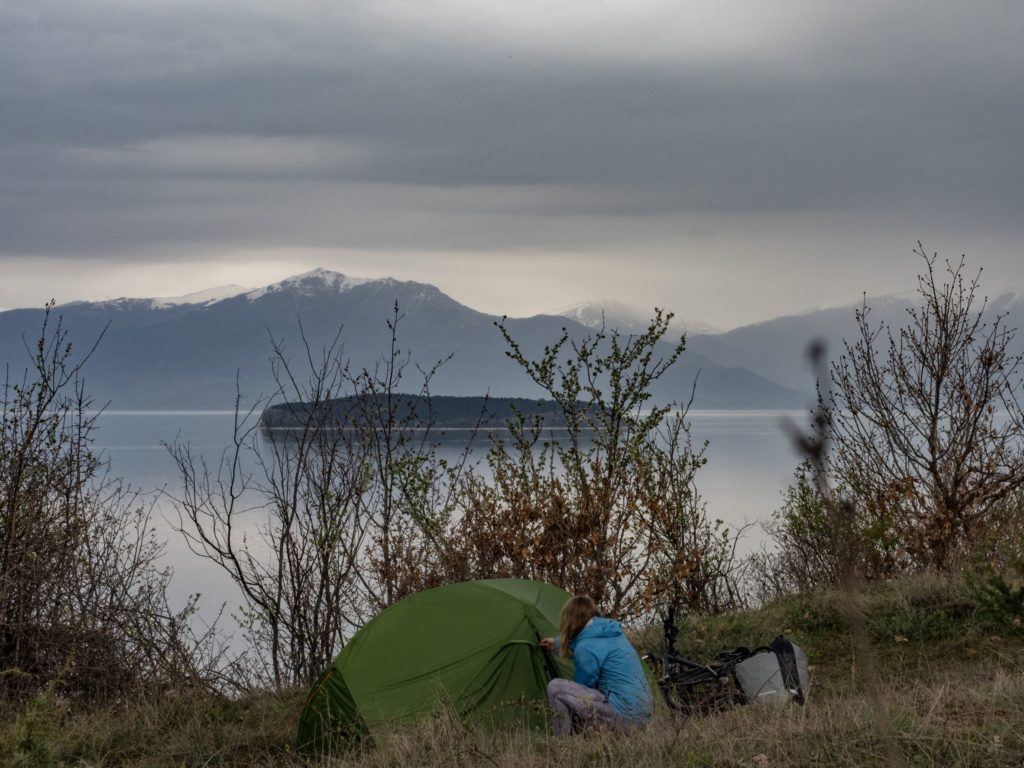Choosing the right sleeping bag for bicycle touring is not easy. There are hundreds of models on the market and plenty of factors you need to consider. Synthetic or down, three-season or four-season, mummy or rectangular. Let me guide you through the most crucial questions you need to ask yourself before this purchase to choose the right sleeping bag for you.
I focus on sleeping bags from a bicycle touring perspective. However, my advice is also applicable to hikers, backpackers, and people travelling with limited luggage space.
For most people, bicycle touring is a package deal with camping. Sleeping in your tent gives you an additional dose of being close to nature and allows you to enjoy the most amazing locations for free.
Is it 100 % free, though? If you are new to camping, you will have to spend quite some money on the gear. Choosing the right sleeping bag will determine whether you wake up fully recovered or sleepy and grumpy because of the cold or discomfort.
How to buy a high-quality sleeping bag without spending a fortune? What are the qualities a sleeping bag should have?
Unfortunately, when it comes to buying a sleeping bag, there is no “one-size-fits-all.” It all depends on your budget, style of travel, destinations, time of the year and personal preferences. Usually, you will have to settle for certain compromises: weight vs warmth, price vs weight etc.
How to know if a sleeping bag will be warm enough for me?
Are you browsing through different sleeping bags in an online store and getting confused about the three different temperature values in the specs of each model? You can feel lost looking at those comfort, limit and extreme ratings and figuring out which one would work best. Let’s focus on the comfort value.
What does a comfort temperature of 0°C mean?
A sleeping bag with a comfort temperature of 0°C should keep an average woman warm by 0 °C for an entire night without additional blankets. An average man would usually have a bit more tolerance to cold because of a higher muscle mass.
You need to remember that a variety of other factors can influence it. If you always wear a warm sweater while everyone is running around in t-shirts and shorts, pick a sleeping bag with a comfort temperature value a few degrees lower. If you haven’t eaten properly and are exhausted, you will also be more prone to freeze.
The producers of camping gear assume that you will be sleeping in a tent or a wind-proof shelter, on an insulating sleeping mat and only with the base layer on.
How are you supposed to know what temperatures you will experience during your bike tour?
If you are an experienced hiker and outdoor enthusiast, you know how cold the nights in the mountains can be. If your route leads through places on high elevation, consider buying a sleeping bag suitable for sub-zero temperatures, even if you are only touring in the summer.
W Kirgistan, some of my campsites were at 3000 metres a.s.l. Summer nights at this altitude can be freezing, even when the valleys are scorching.

With every 100 elevation metres, the temperature drops by about 0,6 °C.
That being said, I would recommend most people get a three-season sleeping bag with comfort temperatures oscillating around zero or slightly below.
If you know you’re only going to camp when it’s warm, e.g. if you are planning a trip along the Spanish coast during the summer, relax and buy something thinner.
If you are looking for a light two-season sleeping bag, consider, for example, the Stoic Nijac sleeping bag.
Should I buy a women’s specific sleeping bag?
Theoretically, women’s sleeping bags are more adjusted to the female anatomy. They have some extra width in the hip area and extra insulation around the feet. In reality, the differences are not so relevant, so you can simply go for a men’s/unisex sleeping bag.
How to choose the right size of sleeping bag?
A more important thing is the size. If you choose a sleeping bag that is too big, it will be more comfortable, but you will freeze more, as it will require more energy to keep the extra air in the sleeping bag warm.
Most shops will specify the height the sleeping bag is suitable for. The total length should be your height +20/25 cm. The best way to find the right size sleeping bag is simply to try it on. If you can lie comfortably in a sleeping bag and there is not too much free space around – this is the one for you.
A down or synthetic sleeping bag?
Another dilemma you will face when buying a sleeping bag for your bicycle tour is whether to buy down or synthetic. Each option has pros and cons.
If you are vegan or allergic to down, your life just became simpler – the decision is made: you should get a synthetic sleeping bag.
If you’re not vegan but care about animals, make sure your down sleeping bag has the Responsible Down Standard (RDS) certificate. The feathers of geese and ducks used to produce sleeping bags with this certificate were treated well (no live plucking and force-feeding, access to comfortable indoor and outdoor spaces).
If you want a down sleeping bag with the RDS certificate, check out Sea To Summit Spark lub Therm-A-Rest Vesper sleeping bag.
Down sleeping bags are usually lighter and more compact than synthetic sleeping bags with the same thermal isolation. This is the main reason why I chose this insulation type.
Folded, my sleeping bag is a 33x20x20 cm package that fits nicely in my pannier. Its weight is less than 900 grams. I also really appreciate how easy it is to pack it. You simply shove it inside the compression bag. When I was a kid, I had to spend ages trying to perfectly fold my old-type synthetic one because otherwise, it would fit into the dedicated bag.
Unfortunately, the compact size and lightweight come with a price. Down sleeping bags are much more pricey than synthetic ones. You will have to spend even 100 euros more for down than a synthetic sleeping bag with the same thermal comfort.
Down sleeping bags almost entirely lose their insulating properties if exposed to humidity. I experienced that once when sleeping under the sky at a beach in Croatia. Even though the temperature was around 20 °C, I woke up freezing because my sleeping bag absorbed the humidity from the sea. Down sleeping bags take a long time to dry, so a synthetic one might be a better option if you travel in places with a lot of rain. I use a down sleeping bag no matter where I go, and even during my rainy trip across Norway, I had no problems with it. I always make sure to close my panniers properly and put my sleeping bag in a plastic bag, just in case.
Some down sleeping bags, like Marmot Atom, have a water-resistant layer to protect down from humidity.
Pros and cons of a down sleeping bag
Pros:
+ Lightweight
+ Compact
+ Durable
Cons:
-not vegan
-expensive
– useless if it gets wet, takes a long time to dry
-complicated to clean
Pros and cons of a synthetic sleeping bag
Pros:
+ cheaper
+ water resistant
+ vegan
+ hypoallergic
+ Easier to clean
Cons:
-heavy
-bulky
-less durable
Not sure if you want a down or synthetic sleeping bag yet? Check different options tutaj.
Mummy or rectangular sleeping bag?
In my opinion, mummy is the only reasonable option. It is more compact, easier to pack, and keeps you warmer. There is no better feeling than the warm and soft hoodie of the sleeping bag wrapped around your head.
Zip or no-zip sleeping bag?
Most sleeping bags come with a zip, and I think they are a better choice.
Pros of a no-zip:
+ No parts that can get broken
+ Lightweight
Cons of a no-zip:
-you can’t open the sleeping bag and use it as a blanket if it gets too warm
Do you need a sleeping bag liner?
Rowerowy sleeping liner is helpful but not essential. This small piece of gear will help you keep your sleeping bag clean. You can wash it in a washing machine without special detergents, so you can postpone cleaning your sleeping bag for quite a while.
A sleeping bag liner can be made of silk, cotton, polyester, or wool. Some of these materials enhance thermal insulation quite well. The weight of the liner depends on the fabric, but if you bring one, you’ll have to carry an extra 100-350 g.

Odnośnik zwrotny: How to wash a sleeping bag? - Wobbly Ride
Odnośnik zwrotny: Cheap bike touring gear- Wobbly Ride - Blog about travel
Odnośnik zwrotny: Bike Touring Packing List (Printable PDF) | Wild Lumens